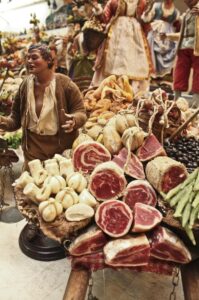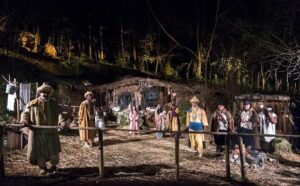ITALIAN MASKS: BETWEEN GAMES, HISTORY, AND CULTURE — Part 2
After exploring some curiosities about the Venice Carnival and other lesser-known carnivals, for this part of the journey through masks and disguises in Italian culture, we will explore the connections with the country’s sense of religiosity.
And particularly what happens where strong catholic traditions meet a solid theatrical presence and passionate attitude to life.
LIVING DEVOTION
Christmas is getting closer, so we would like to share with you a heartwarming tradition of this time of year: the Nativity scene.

Although it is very popular in almost all Italian regions, one of the twenty regions takes this tradition very seriously. In Campania—the region of Naples, Amalfi, Pompei, and Caserta—there is no Christmas without a Nativity scene. Their love and devotion start by dedicating time and space to the preparation of the perfect area of the house which will, for about a month, host a small or large reproduction of the grotto where Christ was supposedly born. Every little detail matters and it is important to get the right pieces. If you need to get some missing characters, there is a place that sells them, but be aware that, although the religiosity is high, here the sacred and the profane cohabit under the same roof and within the same walls.

San Gregorio Armeno, known nationally as “the street of the Nativity scenes”, is located in Naples’ city center, not far from the cathedral. Here you will find examples of fine art, prepared with skills and patience passed down through generations, but be open to finding other interesting pieces that might distract you from your quest. Massive red horns—amulets that, in this part of the country, are believed to bring good luck to those who hold them—hang over statues of the Virgin Mary holding the new-born Christ, surrounded by little reproductions of a young and happy Maradona in his golden era, wearing the iconic blue Napoli football shirt with which he will always be remembered in this part of the planet. This mixture does not happen out of disrespect, but more in a spirit of peaceful cohabitation, guided by a silent recognition and acceptance that life is often made up of opposites.

So, the classic masks of the carnival characters will line up next to the local saint, who is extending their fingers as a sign of blessing, close to a dozen small replicas of pizzas—Margheritas of course. While walking along this street, you will also admire the craftmanship of expert artisans in the shape of model buildings with tiny balconies adorned with plants, cosy homes with doors ajar, brightened by candles and other miniature sources of warmth and light. They are full of detail and depth but empty because they are waiting for the final human pieces to be brought in.

Here, you can buy any pieces you need for your Nativity scene: the cow and the donkey for the background, the shepherd with his sheep, the little girl bringing fresh milk to the grotto, artisans of all kinds, the farmer and all his animals. However, it isn’t unusual to find current political figures standing proudly next to them, often portrayed in ridiculous positions or situations, making them the object of harsh satirical jokes in an attempt to exorcise popular fears and discontent. While you are there, you can also grab a traditional hand-decorated tambourine, while admiring a three-dimensional reproduction of a small village, with shops and squares, whose inhabitants are occupied with their daily activities, while others gather around the Christ.
However, the love for the Nativity scene is so strong that it cannot just be contained within homes—it often occupies entire towns. Between December and the Epiphany on January 6—which officially closes the festive period in Italy—sometimes entire villages (borghi in Italian) are transformed into a stage where the Nativity scenes are embodied by living actors.

One unusual and picturesque example is the Nativity play happens in the small town of Vaccheria, in Caserta, about 40 minutes by car from Naples. The setting is the eighteenth century, and the actors walk through the streets in their costumes, as if they have always lived there. You might find yourself walking next to one of the wise men, accompanying him as he brings his precious gifts to the baby Christ. All the buildings are adapted and prepared for the occasion, and even the old prison house becomes part of this engaging play.


This year the performance will happen on December 16 and 17, 2023 and January 6 and 7, 2024.
For more images of the event, visit the Event Facebook page
🛎️ CONTACT US TODAY to start planning your next vacation in Naples and Campania region to immerse yourself in little-known Italian cultural traditions.
Words by Elisa Spampinato


